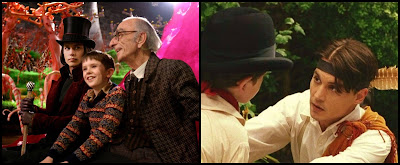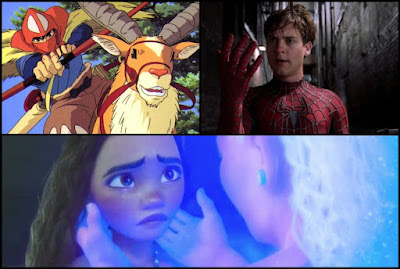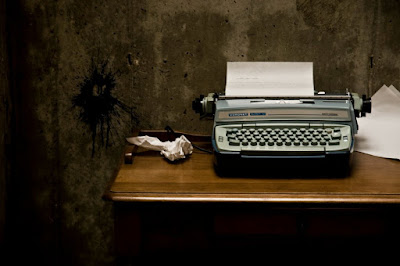Recently, I wrote a couple of articles on the positive steadfast (also known as flat-arc) character. First I did one debunking six myths about them, then I did one on the basic principles of a steadfast, flat-arc protagonist. Today I'm going to talk about the three different categories they fit into, which, as I'll show later, will influence how you write their stories, particularly if they are the protagonists.
Steadfast/flat-arc characters are characters who don't drastically change their worldviews over the course of the narrative. In contrast, a change character will do largely a 180 flip in worldview from the beginning of the story to the end of the story. For example, in Charlie and the Chocolate Factory (2005), Charlie maintains the same worldview at the beginning and at the end. In contrast, in The Emperor's New Groove, Kuzco does a 180 flip in worldview from the beginning to the end, because of the story.
Both types of characters will be tested through the obstacles and conflicts of the middle. The difference is that the steadfast character will (ultimately) remain steadfast to their beliefs in spite of the tests, and the change character will transform because of the tests.
There are positive and negative versions of each type of character. Characters who hold strong or change for the good (or rather, for the accurate worldview--sometimes referred to as the "truth") have positive arcs. While characters who hold strong or change for the worse (or an inaccurate worldview--sometimes called the "lie") have negative arcs.
I've been asked a couple of times to break down how a steadfast protagonist story is structured differently from (or similarly to) a change protagonist story. This is forthcoming, but in the process, I realized I needed to talk about three categories of flat-arc protagonists, because to some extent, that influences how the story is structured.
Now, as with most writing things, this is really more of a spectrum than exact categories, but being able to categorize helps us make informed writing decisions.
In my post, "Principles of the Steadfast, Flat-arc Protagonist," I echoed K. M. Weiland's assertion that doubt is key to creating a meaningful internal journey for the flat-arc character. I pointed out that some steadfast characters doubt very little, while others may be brought to their knees by doubt. But not all doubt is the same, and not all doubts hit with the same force.
This is why it's helpful to break down the steadfast character further. Below we move from little to no doubt, to the most crippling forms of doubt.
Please note that for my examples, I'm specifically using positive steadfast characters. For negative steadfast characters, you'd simply flip the worldview so that they start and end on the inaccurate one.
I've also chosen to focus on protagonists in particular, but most stories will feature a steadfast character, even if the protagonist has a change arc. Considering the following can still help with writing steadfast side characters. (And if you are writing with a change protagonist, it's likely the Influence Character will be a steadfast one).
3 Categories of Steadfast, Flat-arc Characters
1. The Flat-arc Character Experiences Little to No Doubt
It's possible for a flat-arc character to experience practically no doubt. He has the accurate worldview (this is essentially the thematic statement--also called the "truth") at the beginning, knows it's true, and simply uses it to change the world around him.
While this doesn't necessarily make his journey easy, he's less likely to have a rich internal journey. An internal journey probably won't be one of the main plotlines (of which there are six types). This means that the story will likely emphasize a different plotline in its place. If it's not a short story, you'll likely get a combination of three plotlines from this list:
- External Journey
- Relationship/B Story
- Society/World
- Influence Character (in this case, the character with the prominent change arc)
Because the steadfast protagonist isn't doubting his worldview, it's likely in this scenario, there will be more focus on the society/world or the Influence Character changing, as opposed to his own internal struggles.
An example of this type is Charlie Bucket in Charlie and the Chocolate Factory (2005). Because Charlie lacks internal doubt, the Influence Character's journey--in this case, Willy Wonka--gets more focus. We watch how Charlie's innocent questions and steadfastness eventually flips Wonka's inaccurate worldview to the accurate one.
Another example is James Barrie in Finding Neverland, who essentially never doubts the primary thematic statement. Therefore, in place of a strong internal journey, we get more emphasis on the Influence Character, Peter, changing because of James.
* If you are writing with a change protagonist, there is a good chance the Influence Character belongs in this category. In The Emperor's New Groove, Pacha works as the steadfast Influence Character for Kuzco--Pacha doubts his own worldviews very little, and helps Kuzco come to the accurate worldview. However, if you want to give your Influence Character a deeper internal journey, the following options are available.
2. The Flat-arc Character Doubts Applying the Accurate Worldview
A step beyond having no doubt, is doubt applying the accurate worldview--the "truth."
This can manifest in three ways:
- She may question how to actually imbue the environment with the accurate worldview. She may question how to actually do what she needs to do. For example, we all believe no one should go hungry, but how do we actually solve world hunger? Just because we know what's "true" doesn't mean we know how to live it (for ourselves or for society in general).
- She may question her wherewithal. Does she have the skills and strength required to carry the "truth" to victory? Can she survive the costs? Can she make the sacrifices? Maybe she knows what the accurate worldview is and what needs to be done, but she doesn't have the skills to make that happen. What if the costs are so great, she can't ultimately meet them? What if she dies (literally or figuratively) before claiming victory? Here she doubts her capabilities to apply the truth.
- She may question her worthiness. Is she the right person who should be taking this journey? Maybe someone else should be the one doing this instead. Maybe they would do a better job. Maybe she should move aside for them. Or hope someone steps up. Here she doubts she's the one who should apply the truth
An example of the first type is Ashitaka in Princess Mononoke. Ashitaka knows the world needs peace--and that's what he's here to bring. But his struggle is that he doesn't know how to apply a personal truth within, to a wanting world without. He doesn't know how to make the societies around him peaceful. How does one actually do that?
An example of the second type is Peter Parker in Sami Raimi's Spider-man 2. Peter starts out the story wanting to continue to be Spider-man, but the cost to his personal life is so high, he begins to doubt he can survive it (figuratively). What if he doesn't have the wherewithal to keep being Spider-man? What if he can't keep making these steep sacrifices? This is of course strengthened by the loss of his actual superpowers--a metaphor of the doubt he's experiencing.
An example of the third type is Moana. Moana knows that who you are comes from the inside (accurate worldview). But her struggle peaks when she no longer believes she is the right person for the journey. She tells the ocean that it chose wrong--that it made the wrong decision in picking her for this quest.
* An example of a side steadfast character with this doubt, would be Story in Lady in the Water. Cleveland is a change-arc protagonist, and Story is the steadfast Influence Character. At one point, Story confides in Cleveland that she does not think she has what it takes to be her people's leader.
3. The Flat-arc Protagonist Doubts the Accurate Worldview
Through the tests and challenges of the story, the flat-arc protagonist may doubt his true worldview. What if he is wrong? What if the opposing worldview is the right one? Maybe he should bend to the forces around him.
It may be that the steadfast protagonist entertains the opposing worldview only privately.
Or it may be that he actually even begins acting on the opposing worldview (the "lie") for a time.
But in order to be a steadfast protagonist, he will ultimately uphold the accurate worldview at the end.
In Wonder Woman, Diana starts out with the truth that we should fight for the world we believe in (via mercy and love), but through the story, nearly turns her back on it. Maybe humans do deserve justice, like Ares says. In the end, she comes to a greater understanding of the truth, and uses it to defeat the antagonist.
In The Lion King, Simba, as a cub, repeatedly professes his role in the Circle of Life. Like Diana, he may be naive, but he believes in the accurate worldview--every creature has a role to play in a grand design. But the tests at the midpoint beat down his belief, and he spends the second half of the middle acting on the inaccurate worldview (the lie), doing nothing but having fun and eating bugs (unnatural for a lion) with outcasts (who've abandoned their natural roles). Mufasa reminds Simba of who he's destined to be--the one true king. Simba re-embraces the truth and runs to claim his place at Pride Rock.
Worth noting is that in both of these examples, these protagonists have secondary change arcs. Meaning, both stories have a secondary theme (or accurate worldview) that the character flips in. In Wonder Woman, the secondary theme is about the nature of humankind. Diana does a positive change arc in that she moves from believing humans are naturally black and white, to coming to the truth that humans are actually gray--they have both good and bad within them. In The Lion King, the secondary theme is about responsibility. Simba has a positive change arc in that he moves from being irresponsible at the beginning to being responsible at the end.
It's not required that a character who doubts the accurate worldview needs a secondary change arc, that's just a coincidence in my examples. But I wanted to bring it up because such characters can be confusing to learners--as some may argue the characters are steadfast while others may argue that they are change. In reality, it depends on which thematic thread you pull.
This can be true of any of the other steadfast categories. In fact, pretty much any character can have a secondary arc that is the same type as, or a different type from, their primary arc. A character may have two steadfast arcs, each in the same category above or in different categories. Another character may have two change arcs. Or a character may have one of each. But I'll talk about this more in the future, when I break down structure, so don't fret if it sounds confusing right now.
Out of the three categories, it's most likely that the third one will create a more powerful internal journey because the protagonist experiences turmoil by entertaining conflicting belief systems. However, storytelling is not always so black and white. It's possible for a protagonist who doubts his abilities to be more impactful than one who doubts the truth. And it's possible for a protagonist who doubts very little to still have an inspiring journey as he struggles through high stakes and costs and changes those around him. And it's possible still, to give the internal journey of the second category more emphasis than the internal journey of the third category. This is all simply to say that while it's helpful to be aware of the different doubts, there are other elements in play that influence the power of the story.
* An example of a side steadfast character with this doubt might be Peter B. Parker in Spider-verse. He acts as the Influence Character for Miles, but while he may profess belief in the truth, he clearly got lost, as we see him acting on the lie--he quit his marriage, quit working out, quit being productive. To some degree, he's entertaining conflicting belief systems. He must fully re-commit to the truth at the end.
This sort of setup creates an interesting dynamic, because as the protagonist may be coming to the truth as he changes, the Influence Character (who often works as the mentor archetype by helping him see the truth) is now entertaining the lie.
Overlapping Categories
As I said in the beginning, these categories and types are meant to help us make more informed writing decisions. It's more of a spectrum, and not everything is so clear cut. A character may in fact have multiple doubts and even move through different categories.
For example, in Spider-man 2, Peter first doubts his wherewithal--the costs--of being steadfast. Near the midpoint (thanks to his doctor), he doubts that he's the one who is supposed to be Spider-man. Maybe he's not the right person for this job. Then, he begins acting on the inaccurate worldview through the second half the middle--just because he's been given great power, doesn't actually mean he has more responsibility (the lie). He will re-embrace the truth and save the city at the end.
Likewise, while Moana's strongest doubt concerns whether she's the right person, she also shows signs of doubting her wherewithal, which is reflected when her grandmother says she should have never put so much on Moana's shoulders.
Change Arc Characters and Doubt
If you want an internal journey plotline for your steadfast character, some form of doubt is key.
But what about change-arc characters? Does this apply to them?
In reality, change-arc and flat-arc characters have a lot of similarities. They are just different in one critical, significant way: whether or not they change their worldviews.
Because the steadfast character doesn't do a full flip, it brings other elements to the forefront. Things that maybe you couldn't see because you were so focused on the transformation, become more apparent. So there is no reason that at least some of the elements noticeable in a steadfast character can't be brought into your change character.
Of course the change character will experience doubt. He doubts the truth, the accurate worldview. If he's a positive change character, he doubts the truth in the beginning. If he's a negative change character, he doubts the truth at the end. There is no reason he can't, at some point, doubt how to accomplish the journey stretched out before him, or doubt that he has the wherewithal to complete that journey, or that he is the right person for that journey. It's just that in a change arc, the change is usually at the forefront.
Hopefully by now, we are all starting to see that flat-arc characters can have internal journeys that are just as rich as change-arc characters (contrary to some popular beliefs in the writing community). (And I will say, on a personal level, that repeated myth has been a big stumbling block for me.) Soon, I will break down story structure, according to the steadfast, flat-arc protagonist. Stay tuned!



























Another marvelous post, September! Thanks for tackling the steadfast protagonist; it's really helping.
ReplyDeleteI am throwing this out to see if it sparks a reply. I appreciate your post and insights but have been struggling to find mention of a flat arc character who believes a certain "truth" that some believe and some don't. So, this truth is uncertain - just like real life. The character struggles mightily with those who don't accept his truth, but eventually, he is undone by more powerful figures who disagree with his truth and can assert their own. It's a not a hero's journey. He's cancelled. But it's not fiction. It's the story of a key figure in WWII that I'm nearly done writing (90K-words). I am trying to find similar stories but have had no luck. Anything come to mind? Thank you.
ReplyDelete